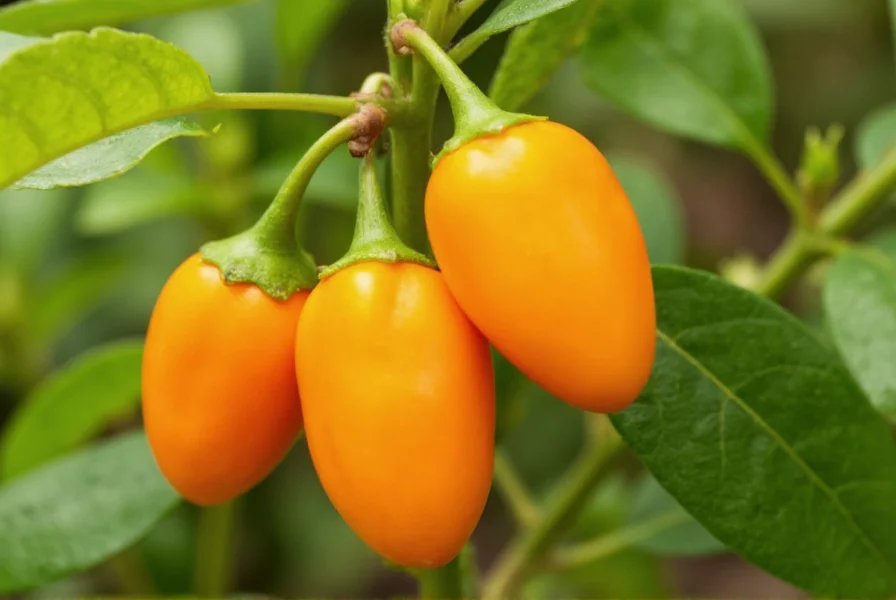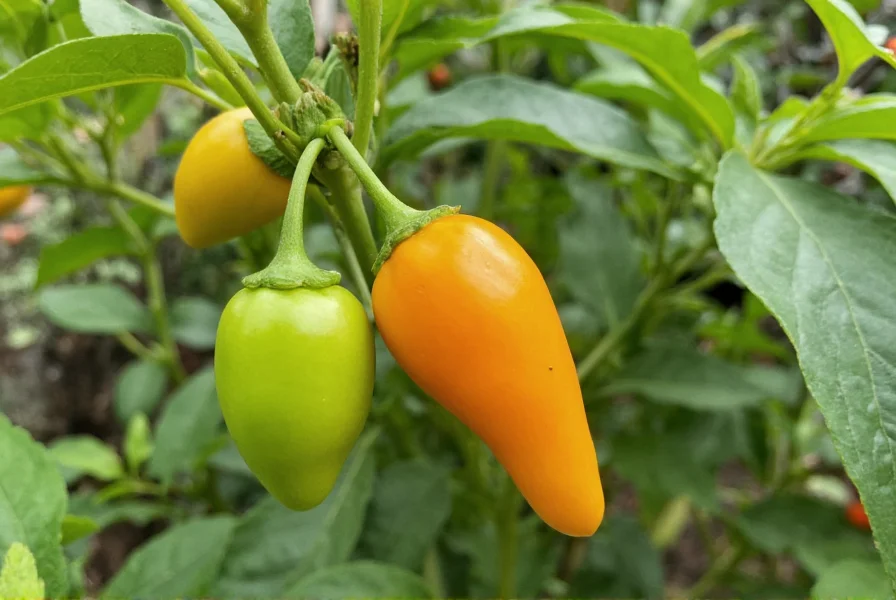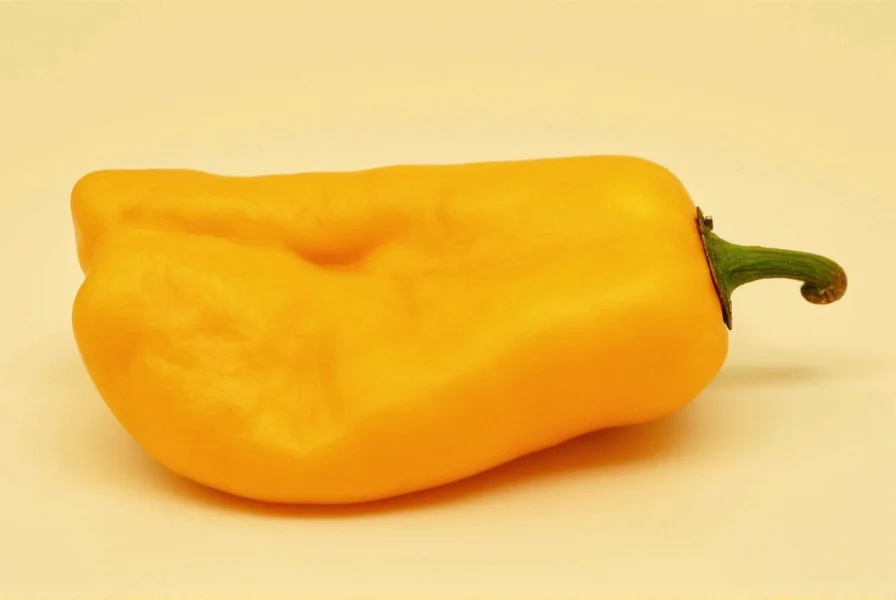The mango pepper, scientifically classified as Capsicum chinense 'Mango,' represents one of the most intriguing fruit-forward chili varieties available to culinary enthusiasts and home gardeners alike. This specialty pepper has gained popularity among hot sauce makers and adventurous cooks seeking to add tropical complexity to their dishes without overwhelming heat. Unlike standard bell peppers or even common hot varieties, the mango pepper delivers a distinctive flavor experience that begins with sweet, citrusy notes before revealing its moderate heat.
What Exactly Is Mango Pepper?
Despite its potentially confusing name, mango pepper isn't a hybrid of mango fruit and black pepper. It's a specific cultivar of Capsicum chinense, the same species that includes habanero and scotch bonnet peppers. The "mango" designation refers to the pepper's distinctive flavor profile that many tasters describe as having pronounced tropical fruit notes reminiscent of ripe mango, particularly in the initial flavor experience before the heat develops.
Botanically, mango peppers produce medium-sized fruits that typically mature from green to vibrant orange or red. The plants grow to about 2-3 feet tall and produce abundant yields under proper growing conditions. Each fruit generally measures 1-2 inches in length with the characteristic lantern shape common to many C. chinense varieties.
Mango Pepper Characteristics and Heat Level
Understanding mango pepper heat level is essential for culinary applications. These peppers typically register between 100,000-350,000 Scoville Heat Units (SHU), which places them firmly in the same heat category as habaneros. However, experienced chili enthusiasts note that mango peppers often seem subjectively milder than standard orange habaneros due to their pronounced fruitiness that balances the heat.
| Pepper Variety | Scoville Heat Units | Flavor Profile | Color When Mature |
|---|---|---|---|
| Mango Pepper | 100,000-350,000 | Tropical fruit, mango-like, citrusy | Orange to red |
| Standard Habanero | 100,000-350,000 | Floral, citrus, intense heat | Orange |
| Scotch Bonnet | 100,000-350,000 | Sweet, fruity, Caribbean notes | Red, orange, yellow |
| Jalapeño | 2,500-8,000 | Grassy, bright | Red |
When evaluating mango habanero pepper characteristics, the flavor progression follows a distinctive pattern: initial sweet, tropical notes (reminiscent of mango and citrus), followed by floral undertones, and finally the characteristic C. chinense heat that builds gradually rather than hitting immediately. This flavor complexity makes mango peppers particularly valuable for culinary applications where balance is key.

Culinary Applications of Mango Peppers
The unique flavor profile of mango peppers makes them exceptionally versatile in the kitchen. Professional chefs and home cooks seeking mango pepper culinary uses often incorporate them into:
- Hot sauces - Their fruity profile creates balanced hot sauces that don't overwhelm with heat
- Salsas and chutneys - Complements tropical fruits like pineapple and mango
- Marinades - Adds complexity to chicken, fish, and pork dishes
- Pickling - Creates uniquely flavored pickled peppers
- Cocktail infusions - Adds subtle heat and tropical notes to spirits
When working with mango peppers, remember that the heat concentrates in the placenta (the white ribs inside) and seeds. For milder applications, remove these parts before use. The flesh itself contains significantly less capsaicin while retaining the distinctive mango-like flavor.
Growing Mango Peppers at Home
For gardeners interested in growing mango peppers at home, these plants require conditions similar to other C. chinense varieties. They thrive in warm climates with plenty of sunlight and well-draining soil. Key growing considerations include:
- Start seeds indoors 8-10 weeks before last frost date
- Maintain soil temperature around 80-90°F (27-32°C) for optimal germination
- Provide 6-8 hours of direct sunlight daily
- Water consistently but avoid waterlogged soil
- Harvest when peppers reach full color (typically orange to red)
Mango pepper plants typically mature in 75-90 days from transplanting. The peppers can be harvested green but will develop their characteristic mango-like flavor and full heat potential when allowed to ripen to their final color.

Mango Pepper vs Habanero: Understanding the Differences
Many people wonder about mango pepper vs habanero differences. While both belong to the Capsicum chinense species and share similar heat levels, they have distinct characteristics:
- Flavor: Mango peppers have more pronounced tropical fruit notes, while standard habaneros tend toward floral and citrus flavors
- Heat progression: Mango peppers often have a more gradual heat build-up compared to the sometimes abrupt heat of habaneros
- Shape: Mango peppers typically have a slightly more elongated shape than the classic lantern-shaped habanero
- Culinary use: Mango peppers work better in applications where tropical fruit notes are desirable
It's worth noting that some seed companies market specific habanero cultivars as "mango habanero," which can create confusion. True mango pepper varieties maintain consistent characteristics that distinguish them from standard habaneros.
Nutritional Profile and Health Benefits
Like other chili peppers, mango peppers contain capsaicin (responsible for heat) along with valuable nutrients:
- Excellent source of vitamin C (one pepper provides over 100% of daily requirement)
- Good source of vitamin A and antioxidant carotenoids
- Contains vitamin B6, potassium, and dietary fiber
- Low in calories (approximately 18 calories per 100g)
The capsaicin in mango peppers may offer several potential health benefits, including pain relief, improved metabolism, and anti-inflammatory effects. However, these benefits apply to chili peppers generally and aren't unique to the mango variety.
Where to Find Mango Peppers
Finding fresh mango peppers can be challenging depending on your location. Your best options include:
- Specialty farmers' markets, particularly those featuring heirloom produce
- Online seed retailers for growing your own plants
- Specialty hot sauce producers who may sell fresh peppers seasonally
- International grocery stores focusing on Caribbean or Latin American products
When fresh peppers aren't available, look for hot sauces, dried peppers, or pepper flakes featuring mango peppers. Many artisanal hot sauce makers specifically highlight mango pepper varieties for their distinctive flavor profile.
Conclusion
Mango pepper represents a distinctive variety within the Capsicum chinense family that offers culinary enthusiasts a unique combination of tropical fruit flavors and moderate heat. Understanding what does mango pepper taste like helps cooks make informed decisions about incorporating this specialty pepper into their recipes. Whether you're growing mango peppers at home or seeking them out for culinary experimentation, this variety provides a flavorful alternative to standard habaneros with its distinctive mango-like notes that can elevate both savory and sweet dishes.
What is the difference between mango pepper and regular habanero?
Mango pepper is a specific cultivar of habanero (Capsicum chinense) with a more pronounced tropical fruit flavor profile reminiscent of mango. While both register similarly on the Scoville scale (100,000-350,000 SHU), mango peppers typically have a more gradual heat build-up and distinctive flavor notes that differentiate them from standard orange habaneros.
Can I substitute mango pepper in recipes that call for habanero?
Yes, you can substitute mango pepper for habanero in most recipes, but be aware that the flavor profile will differ. Mango peppers offer more tropical fruit notes, which may enhance certain dishes but could alter the intended flavor balance. Start with slightly less than the recipe specifies, as the heat experience may differ even if the Scoville rating is similar.
How hot is a mango pepper compared to other common peppers?
Mango peppers range from 100,000-350,000 Scoville Heat Units, making them approximately 10-40 times hotter than jalapeños (2,500-8,000 SHU) and comparable to standard habaneros. However, due to their pronounced fruitiness, they often seem subjectively milder than other peppers in the same heat range.
Where can I buy mango pepper seeds to grow my own plants?
Mango pepper seeds are available from specialty online seed retailers that focus on heirloom or hot pepper varieties. Look for reputable seed companies that specifically list 'Mango' as the variety name rather than generic 'habanero' seeds. Many hot pepper enthusiast forums also offer seeds through community exchanges.
Do mango peppers actually taste like mango fruit?
Mango peppers don't taste exactly like mango fruit, but they do have distinctive tropical fruit notes that many tasters describe as reminiscent of mango, particularly in the initial flavor experience before the heat develops. The flavor profile includes citrus and floral notes common to habaneros, but with a more pronounced sweet-tropical character that justifies the 'mango' designation.











 浙公网安备
33010002000092号
浙公网安备
33010002000092号 浙B2-20120091-4
浙B2-20120091-4